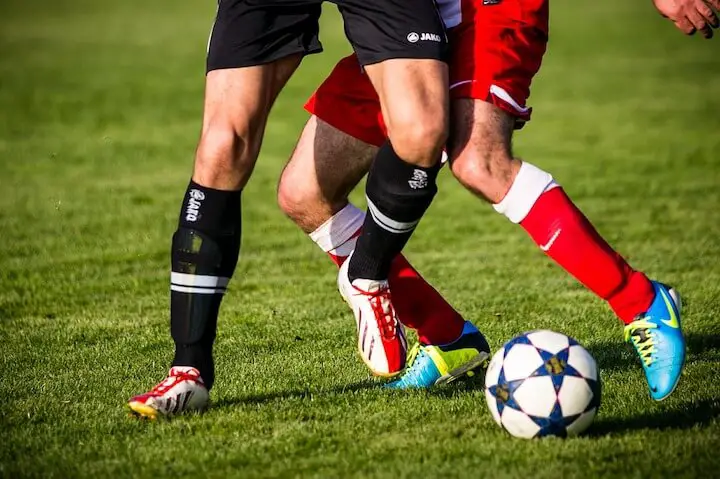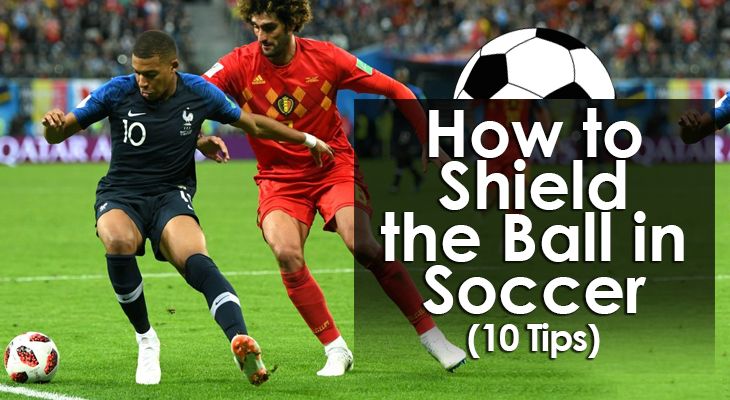How to Shield the Ball Properly in Soccer (10 Tips)
At any level, shielding the ball in a game of soccer is an important skill to have.
This is true more so for players in specific positions than others, but useful for everyone.
Shielding the ball is when a player in possession places their body as a barrier between the ball and the opponent.
The player literally uses their body as a “shield” to keep possession of the ball and make it harder for the opponent to steal.
It sounds simple enough, but there are techniques that help with shielding the ball better than the average person.
It goes beyond simply putting your body in the way, as skilled defenders can still nick the ball if it’s not done right.
Why Do You Need To Shield The Ball?
A straightforward answer to this is -- “to keep possession of the ball”.
The more detailed answer will go further to explain how keeping possession in this manner can benefit your team.
Depending on the situation, shielding the ball can help your team in both defense or offense.
Shielding on Defense
Picture a team that is leading a game 1-0 in the 90th minute, just before the game ends.
A player on the winning team gains possession of the ball and immediately takes it toward the corner flag, shielding the ball from the opponent.
In that scenario, shielding the ball is a defensive tactic to run down the clock.
The player makes sure that the opponent does not have a chance to score in the last minute.
If they don’t win possession, they can’t score.
Shielding on Offense
For attack, imagine a lone striker that receives the ball with their back to goal and a defender behind.
It’s hard for the player to turn without getting dispossessed, and there are no immediate options to pass the ball to.
Shielding the ball here could be a very useful tactic for keeping the defender busy while waiting for support from a teammate.
When that support arrives, the attacker can lay the ball off and keep the attack alive.
There are countless other scenarios of defense and attack where shielding the ball may be necessary, but you get the idea.

Types Of Ball Shielding Techniques
We’ll get to the actual techniques in a bit, but you should know that there are two commonly used types of ball shielding with respect to body placement.
1. Back to Body Technique
First, there is the “Back to Body” technique.
This is when the player in possession stands between the ball and the opponent with their back facing the opponent.
Here, the player holds a stance that braces the body for impact, keeping low to the ground (butt out).
The player may also hold their arms out to prevent the opponent from reaching around them.
2. Side to Body Technique
Then, there’s the “Side to Body” technique.
Instead of backing the opponent, the player shields the ball by standing sideways between it and the opponent.
This method creates even more distance between the opponent and the ball.
When standing in the Side to Body shield position, one foot will be further away from the opponent than the other.
That foot should be in control of the ball.
With the “Back to Body” technique, there is always the risk that the opponent can still steal the ball from between your legs if your stance is not right.
Players reduce that risk with the “Side to Body” method.

Learning The Art of Shielding The Ball
Regardless of the method, there are common best practices for shielding the ball in soccer.
The list below covers the main points, but it is inexhaustive.
- Keep your head up and be aware of your surroundings. You need to know which direction the opponent is coming from.
- After anticipating where the pressure will come from, position yourself in the appropriate stance -- bend your knees, lower your butt and prepare for impact.
- Try and keep the foot with the ball further away from the standing foot to create extra distance between you and the opponent.
- If the purpose for shielding the ball is to simply lay off a one-time pass to a teammate, the “Back to Body” technique is ideal.
- Don’t forget to use your arms -- be careful not to swing them at the opponent though, simply use them as an added barrier.
- The rules of the game allow you to place your arm on the chest of the opponent for balance, but be careful not to push as it would be a foul.
- If standing sideways and leaning one arm on the opponent, raise the other arm in the opposite direction for better balance.
- Do not simply wait for the opponent to push against you before holding a firm position; use your upper body strength to prepare ahead.
- If you feel sufficient contact and you realize that you’re losing your balance, you can try to dribble the ball away if possible or go to the ground to win a foul.
Extra Tip: As a defender, shielding the ball from an attacker within your own final third can be risky.
In many cases, it would be beneficial to play it safe and clear the ball instead of trying to shield it.
This is because of the chance that an extra attacker will join in trying to win the ball.
Shielding the ball against two players would be a much harder task.
Needless to say, losing possession in your final third could very easily lead to a goal.
Conclusion:
Now you have all the basics sorted out, but you can gain even more knowledge from watching and studying how professional soccer players do it.
A few players very adept at shielding the ball include:
- Andres Iniesta (Midfielder)
- Eden Hazard (Winger),
- Virgil Van Dijk (Center-Back),
- Romelu Lukaku (Striker)
If you can apply everything you learn appropriately, you’ll be an expert in no time!

